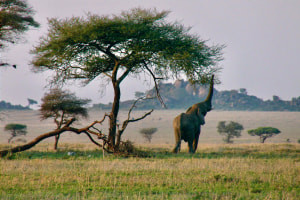Wildlife conservation preserves and protects animals, plants and their habitat. It is important because it ensures that future generations will appreciate and enjoy our natural world. Wildlife conservation requires a sound understanding of genes and species, how they interact with their environment and how they are affected by human activities. This course will help you understand conservation theories and their applications to wildlife conservation. We begin by introducing you to conservation and its history. Then we examine the ethics and values of protection, the concept of biodiversity and its benefits. Furthermore, we research genes' role in biodiversity and the relationship between species and their ecosystems. We will demonstrate methods of maintaining ecosystem and structural biodiversity.
An ecosystem relates to how different living and nonliving organisms live close to each other and how they interact. This relationship significantly affects other creatures and plants that live in the same or similar areas. In this course, we will introduce you to ecosystems and ecological diversity. You will learn about ecosystem diversity, species diversity and how to increase the stability of ecosystems. Discover the landscapes of ecosystems, how they affect their stability and how plant and animal species interact in an ecosystem, studying the intrinsic value of species and their conservation status. This course covers the anomalies that result in the rarity of species and the various instrumental values of species, such as economic, scientific, educational, ecological values and more.
Have you ever wondered why some species become extinct? To some degree, extinction is natural and could be due to several underlying factors. However, the demise of species from the Earth is ongoing and rates have varied over time. This course covers both the theoretical and practical aspects of wildlife conservation. It would help you gain a deeper understanding of why species become extinct and the critical steps to take to avert species extinction. You will learn about wildlife harvesting, control, ecosystem management and conservation. In addition, the challenges of the ocean are posing disastrous consequences on marine biodiversity. In the final part of the course, we will study the ocean's challenges, its impact on marine species and the solutions to these problems. This course is essential for biologists and learners who care about the sustainability and conservation of wildlife for future generations. So why wait? Start this free course today.
What You Will Learn In This Free Course
View All Learning Outcomes View Less All Alison courses are free to enrol, study, and complete. To successfully complete this Certificate course and become an Alison Graduate, you need to achieve 80% or higher in each course assessment.
Once you have completed this Certificate course, you have the option to acquire an official Certificate, which is a great way to share your achievement with the world.
Your Alison certificate is:
- Ideal for sharing with potential employers.
- Great for your CV, professional social media profiles, and job applications.
- An indication of your commitment to continuously learn, upskill, and achieve high results.
- An incentive for you to continue empowering yourself through lifelong learning.
Alison offers 2 types of Certificate for completed Certificate courses:
- Digital Certificate: a downloadable Certificate in PDF format immediately available to you when you complete your purchase.
- Physical Certificate: a physical version of your officially branded and security-marked Certificate
All Certificate are available to purchase through the Alison Shop. For more information on purchasing Alison Certificate, please visit our FAQs. If you decide not to purchase your Alison Certificate, you can still demonstrate your achievement by sharing your Learner Record or Learner Achievement Verification, both of which are accessible from your Account Settings.











 Avg. Hours
Avg. Hours  Contains Video
Contains Video  CPD Accredited
CPD Accredited 
 Total XP:
Total XP: 
 Knowledge & Skills You Will Learn
Knowledge & Skills You Will Learn 







